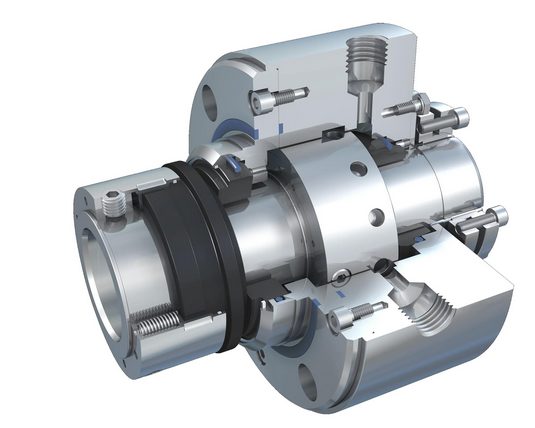Mechanical seals for chemical pumps
The mechanical seal of the chemical pump is a vital part of the chemical equipment, which is directly related to the operating efficiency and safety of the equipment. The following is a detailed introduction to the mechanical seal of the chemical pump:
1. Definition and working principle
Mechanical seal, also known as end face seal, is an indispensable part in fluid machinery and power machinery. It is mainly composed of two sealing surfaces that are perpendicular to the shaft and rotate relative to each other. The dynamic ring is pressed on the impeller shaft, and the static ring is installed on the sealing seat of the cover chamber. The two ends are always fitted to each other through elastic elements to achieve the purpose of sealing. Mechanical seals can prevent fluid leakage and prevent external dust and other harmful substances from invading the equipment.
2. Structural features
Mechanical seals have a variety of structural forms to meet the needs of different working conditions. Mainly include:
Single-end face, double-end face and multi-end face seals: classified according to the number of sealing surfaces, double-end face seals have sealing surfaces at both ends, usually used in occasions with higher sealing requirements.
Balanced and unbalanced seals: Balanced seals are designed to make the pressure on both sides of the sealing surface basically equal, thereby reducing the wear and leakage of the sealing surface.
Single (large) spring and multiple (small) spring seals: classified according to the number and type of springs, multiple spring seals usually have better adaptability and stability.
Internal flow type and external flow type seals: classified according to the flow direction of the medium, the flow direction of the medium of the internal flow type seal is opposite to the direction of the centrifugal force, suitable for high pressure occasions.
3. Material selection
The material selection of mechanical seals is crucial to their performance and life. Sealing surface materials usually include hard materials and soft materials:
Hard materials: such as silicon carbide, cemented carbide, etc., have high hardness, corrosion resistance and wear resistance. Silicon carbide is particularly suitable for occasions with high corrosion resistance requirements.
Soft materials: such as graphite, etc., have good self-lubrication and chemical inertness. In practical applications, in order to improve the performance of graphite, it is often impregnated.
Auxiliary sealing ring materials mainly include elastomers (such as rubber), plastics (such as polytetrafluoroethylene), etc. Polytetrafluoroethylene is widely used due to its excellent chemical corrosion resistance.
4. Application and precautions
Mechanical seals are widely used in chemical pumps. Their reliable operation, low leakage, and long service life make them the most important shaft sealing method for chemical equipment. However, the following points should also be noted during use:
Correct installation: Ensure that the mechanical seal is installed correctly to avoid leakage and damage caused by improper installation.
Regular inspection: Regularly inspect and maintain the mechanical seal to detect and deal with potential problems in a timely manner.
Reasonable selection: Select the appropriate mechanical seal model and material according to the actual working conditions of the chemical pump.
Pay attention to the characteristics of the medium: Different media have different corrosiveness and abrasiveness to the mechanical seal, and it is necessary to select the appropriate sealing material according to the characteristics of the medium.





